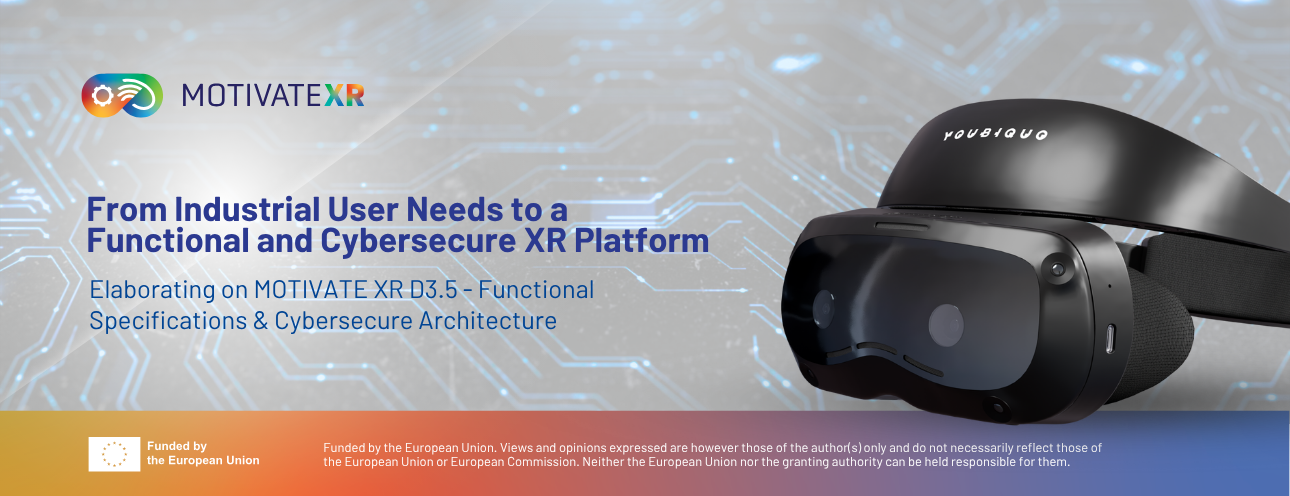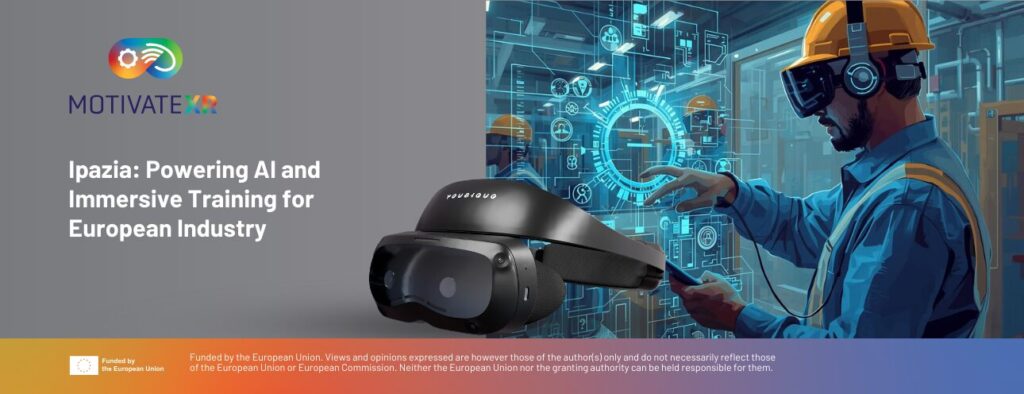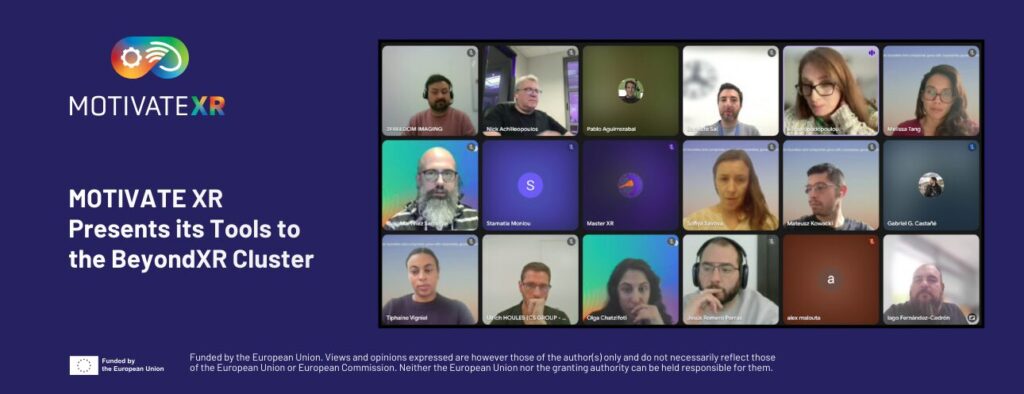In a previous episode, the MOTIVATE XR consortium engaged with end-users across five industrial sectors to identify their expectations, constraints, and ambitions for XR technologies.
Deliverable D3.5 – Functional Specifications and Cybersecure Architecture is a foundational milestone in the MOTIVATE XR project. It defines the technical and functional backbone of a European XR platform designed to empower industrial users with immersive training and assistance tools—securely, scalably, and without the need for programming skills.
This deliverable translates the needs of industrial stakeholders into a modular architecture and a comprehensive set of functionalities, paving the way for real-world deployment across five key sectors: aerospace, home appliances, aluminium, energy distribution, and human-robot collaboration.
A Modular Platform Built Around Two Core Phases
The MOTIVATE XR platform architecture is structured around two main pillars:
- Authoring Phase: where XR content is created using tools for 3D scanning, AI-assisted document processing, digital twin integration, and no-code scenario design.
- Experiencing Phase: where users interact with XR content through immersive training, remote assistance, or real-time guidance.
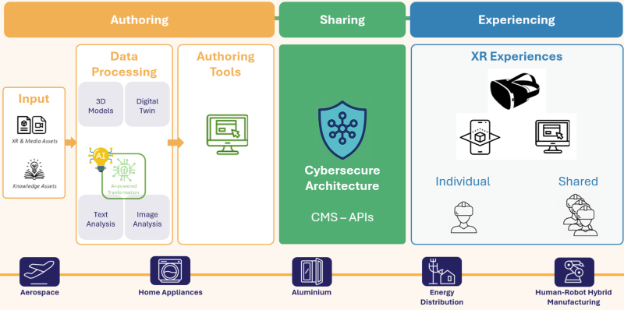
From Industrial Needs to Functional Capabilities
The deliverable outlines a wide range of capabilities that the platform must support, including:
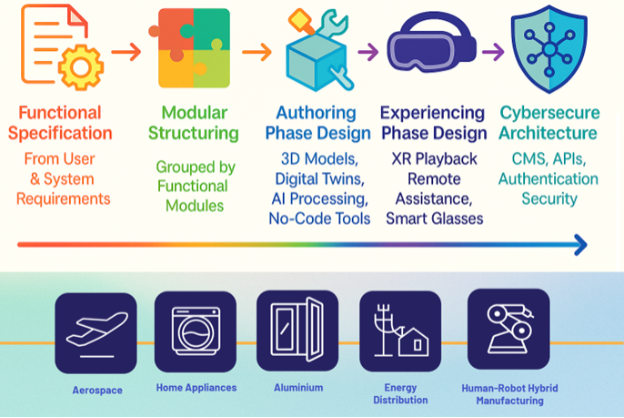
- 3D Model Acquisition: using photogrammetry, LiDAR, and videogrammetry tools to generate accurate digital replicas of physical assets.
- Digital Twin Integration: enabling real-time data visualisation and interaction with physical systems through spatially enriched digital twins.
- AI Document Processing: transforming technical manuals and schematics into structured knowledge that can be used to build XR training content.
- No-Code Authoring Tools: allowing domain experts to create immersive XR scenarios using intuitive interfaces like Inscape VTS Editor, Narrative Editor, and KAYROX.
- Multi-Device XR Playback: delivering content across VR headsets, AR glasses, tablets, and PCs, with support for standalone and supervised training modes.
These capabilities are concretely illustrated throughout the deliverable with concrete examples and visual workflows presenting the overall cybersecure architecture of the platform.
AI That Understands Industrial Knowledge
One of the most innovative aspects of the platform is its AI-powered document processing engine. It can:
- Parse technical documents (PDFs, images, diagrams);
- Extract relevant procedures, tools, and safety information;
- Build knowledge graphs for use in XR authoring tools;
- Adapt to specific domains (e.g., aircraft maintenance, home appliance maintenance, aluminium assembly).
This AI modules bridge the gap between traditional documentation and immersive training, enabling faster content creation and better knowledge transfer.
XR Experiences Designed for Real-World Use
The platform supports a wide range of XR experiences, including:
- Immersive training with realistic simulations and performance tracking
- Remote assistance via AR telepresence and expert guidance
- On-device authoring for creating or editing content directly in the field
The LeonardoXR smart glasses, developed by our partner Youbiquo, play a key role in this ecosystem. They feature advanced gesture recognition, see-through AR capabilities, and AI-powered interaction—making them ideal for hands-free operation in industrial environments.
A Cybersecure Architecture at the Core
Security is built into the platform from the ground up. The architecture includes a secure headless CMS for authentication, Role-Based Access Control for precise permissions, end-to-end data encryption, and comprehensive audit logging. It supports RESTful API integration and flexible deployment across cloud, on-premises or hybrid environments.
Pilots and Future updates
The specifications and architecture defined in D3.5 guide the implementation for pilots in five industrial domains. Each pilot will use a tailored combination of modules, tools, and devices to address specific training and operational challenges.
Given that the project follows an iterative process, an initial beta version will be released and evaluated to collect feedback from end-users. This feedback will guide the development of further improvements, to build the final version of the MOTIVATE XR platform.
Looking ahead, the upcoming second version of the deliverable will include detailed mappings between pilots and platform components, further refining the deployment strategy, ensuring that MOTIVATE XR remains aligned with real-world industrial needs.
Author

CS GROUP
Baptiste SAÏ is a project manager at CS GROUP, specialising in projects in the field of software development for industrial innovation, simulation, virtual training, and immersive technologies. Since 2018, he has led complex software projects bridging R&D and operational deployment around award-winning products like Inscape and Crimson. His work focuses on user-centric design, AR/VR solutions, and digital transformation in high-stakes industrial environments.
